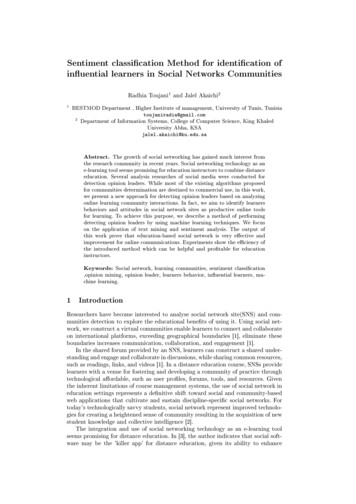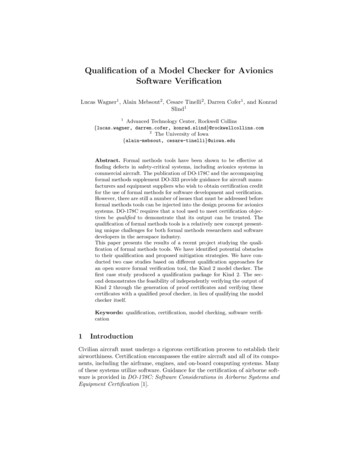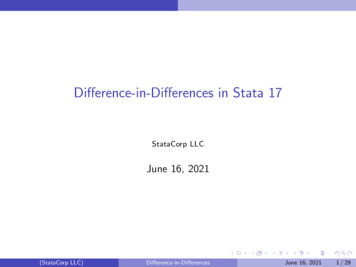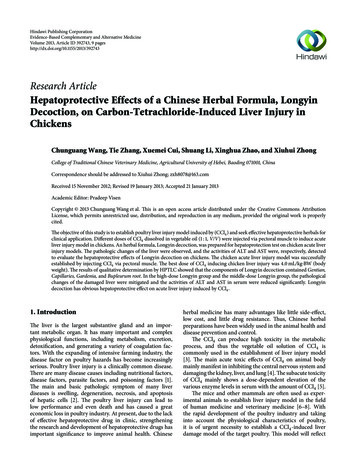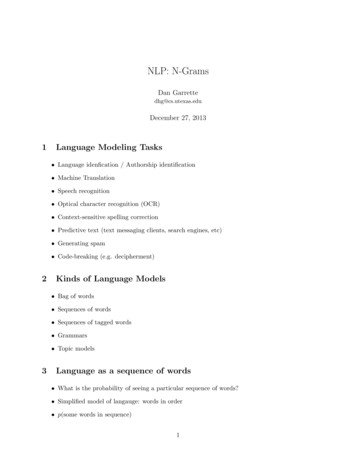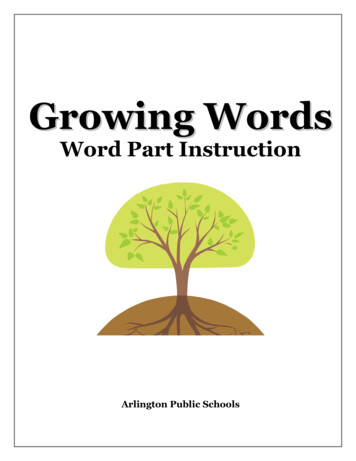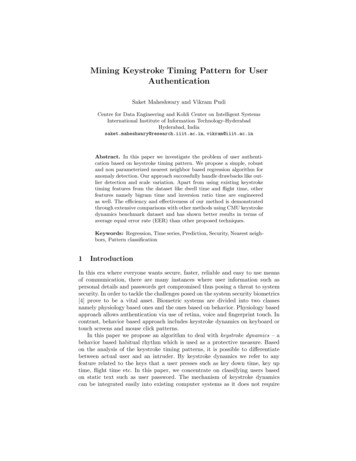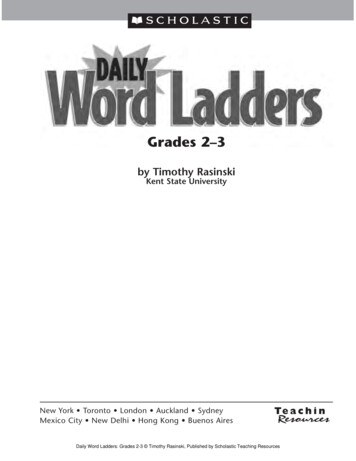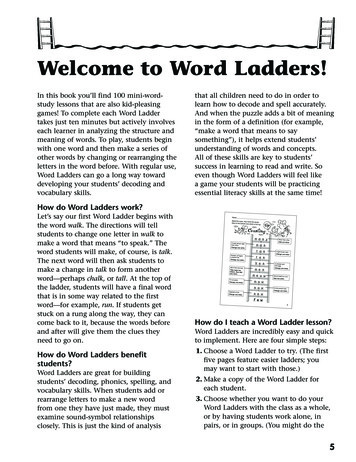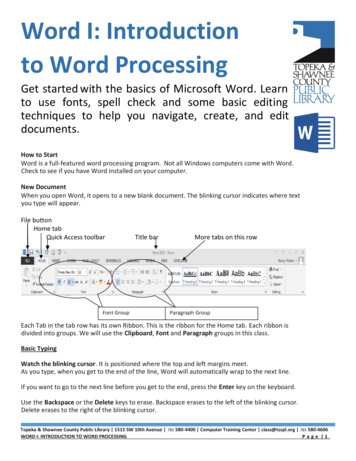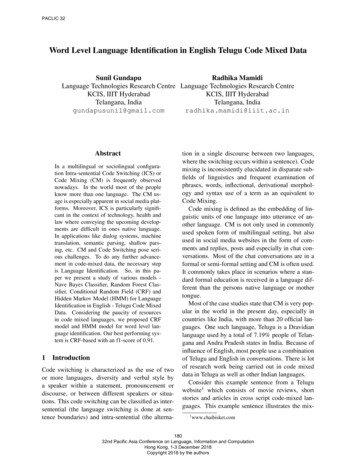
Transcription
PACLIC 32Word Level Language Identification in English Telugu Code Mixed DataRadhika MamidiSunil GundapuLanguage Technologies Research Centre Language Technologies Research CentreKCIS, IIIT HyderabadKCIS, IIIT HyderabadTelangana, IndiaTelangana, omAbstractIn a multilingual or sociolingual configuration Intra-sentential Code Switching (ICS) orCode Mixing (CM) is frequently observednowadays. In the world most of the peopleknow more than one language. The CM usage is especially apparent in social media platforms. Moreover, ICS is particularly significant in the context of technology, health andlaw where conveying the upcoming developments are difficult in ones native language.In applications like dialog systems, machinetranslation, semantic parsing, shallow parsing, etc. CM and Code Switching pose serious challenges. To do any further advancement in code-mixed data, the necessary stepis Language Identification. So, in this paper we present a study of various models Nave Bayes Classifier, Random Forest Classifier, Conditional Random Field (CRF) andHidden Markov Model (HMM) for LanguageIdentification in English - Telugu Code MixedData. Considering the paucity of resourcesin code mixed languages, we proposed CRFmodel and HMM model for word level language identification. Our best performing system is CRF-based with an f1-score of 0.91.1IntroductionCode switching is characterized as the use of twoor more languages, diversity and verbal style bya speaker within a statement, pronouncement ordiscourse, or between different speakers or situations. This code switching can be classified as intersentential (the language switching is done at sentence boundaries) and intra-sentential (the alterna-tion in a single discourse between two languages,where the switching occurs within a sentence). Codemixing is inconsistently elucidated in disparate subfields of linguistics and frequent examination ofphrases, words, inflectional, derivational morphology and syntax use of a term as an equivalent toCode Mixing.Code mixing is defined as the embedding of linguistic units of one language into utterance of another language. CM is not only used in commonlyused spoken form of multilingual setting, but alsoused in social media websites in the form of comments and replies, posts and especially in chat conversations. Most of the chat conversations are in aformal or semi-formal setting and CM is often used.It commonly takes place in scenarios where a standard formal education is received in a language different than the persons native language or mothertongue.Most of the case studies state that CM is very popular in the world in the present day, especially incountries like India, with more than 20 official languages. One such language, Telugu is a Dravidianlanguage used by a total of 7.19% people of Telangana and Andra Pradesh states in India. Because ofinfluence of English, most people use a combinationof Telugu and English in conversations. There is lotof research work being carried out in code mixeddata in Telugu as well as other Indian languages.Consider this example sentence from a Teluguwebsite1 which consists of movie reviews, shortstories and articles in cross script code-mixed languages. This example sentence illustrates the mix1www.chaibisket.com18032nd Pacific Asia Conference on Language, Information and ComputationHong Kong, 1-3 December 2018Copyright 2018 by the authors
PACLIC 32ing being addressed in this paper:Example:“John/NE nuvvu/TE exams/ENbaaga/TE prepare/EN aithene/TE ,/UNIV first/ENclasslo/TE pass/EN avuthav/TE ./UNIV”. (Translation into English: John, you will pass in the firstclass, even if the exams are well prepared). Thewords followed by /NE, /TE, /EN and /UNIV correspond to Named Entity, Telugu, English and Universal tags respectively. In the above example somewords exhibit morpheme level code mixing, like in“classlo” : “class” (English word) “lo” (pluralmorpheme in Telugu). We also consider the clitiqueslike supere: super (English root word) e (clitique)as code mixed.We present some approaches to solve the problem of word level language identification in TeluguEnglish Code Mixed data. The rest of this paper isdivided into five sections.In section 2, we discuss the related work, followedby data set and its annotation in section 3. Section4 describes the approaches for language identification. And finally section 5 reports Results, Conclusion and Future Work.2Related WorkResearch on code switching is decades old Gold(1967) and a lot of progress is yet to be made. BrajB., Kachru (1976) explained about the structure ofmultilingual languages organization and languagedependency in linguistic convergence of code mixing in an Indian Perspective. The examination ofsyntactic properties and sociolinguistic constraintsfor bilingual code switching data was explored bySridhar et al. (1980) who contended that how ICSshows impact on bilingual processing. Accordingto Noor Al-Qaysi, Mostafa Al-Emran (2017) codeswitching in social networking websites like Facebook, Twitter and WhatsApp is very high. The result of such case studies indicated that 86.40% of thestudents using code switching on social networks,whereas 81% of the educators do so.One of the basic tasks in text processing is Part ofSpeech (POS) Tagging and it is primary step in mostof NLP. Word level Language Identification can belooked at as a task similar to POS tagging. For POStagging task Nisheeth Joshi et al. (2013) developeda Hidden Markov Model based tagger in which theytake one word in a sentence as a data point. To figure out this sequence labeling classification problemthey consider the words as observations and POStags as the hidden states. Kovida at el. (2018), withthe use of internal structure and context of word perform POS tagging for Telugu-English Code Mixeddata.Language Identification issue has been addressedfor English and Hindi CM data. For this problemHarsh at el. (2014) constructed a new model with thehelp of character level n-grams of a word and POStag of adjoining words. Amitava Das and Bjrn Gambck (2014) modeled various approaches like unsupervised dictionary based approach and supervisedSVM word level classification by considering contextual clues, lexical borrowings, and phonetic typing for LI in code mixed Indian social media text.Ben King and Steven Abney (2013) elaborate theLI problem as a monolingual text of sequence labeling problem. The authors used a weakly supervisedmethod for recognizing the language of words in themixed language documents. For language identification in Nepali - English and Spanish - English dataUtsab Barman et al. (2014) extract the features likeword contextual clues, capitalization, char N-Gramsand length of word and more features for each word.These features are input for the traditional supervised algorithms like K-NN and SVM.Indian languages are relatively resource poor languages. Siva Reddy and Serge Sharoff (2011) aremodeled a cross language POS Tagger for Indianlanguages. For an experimental purpose they usedthe Kannada language by using the Telugu resourcesbecause Kannada is more similar to Telugu. To doeffective text analysis in Hindi English Code mixedsocial media data Sharma et al. (2016) are stimulatethe shallow parsing pipeline. In this work the authors modeled a language identifier, a normalizer, aPOS tagger and a shallow parser.Most of the experiments have been carried out byusing dictionaries, supervised classification modelsand Markov models for language identification. Finally, most of the authors concluded that languagemodeling techniques are more robust than dictionarybased models.We attempted this language identification problem with different classification algorithms to analyze the results. According to our knowledge, until18132nd Pacific Asia Conference on Language, Information and ComputationHong Kong, 1-3 December 2018Copyright 2018 by the authors
PACLIC 32now no work has been done on language identification in Telugu-English Code-mixed data.3Dataset Annotation and StatisticsWe use the English Telugu code mixed dataset forlanguage identification from the Twelfth International Conference on Natural Language Processing(ICON-2015). The dataset is comprised of Facebook posts, comments, replies to comments, tweetsand WhatsApp chat conversations. This dataset contains 1987 code-mixed sentences. These sentencesare tokenized into words. And the tokenized wordsof each sentence are separated by new line. Thedataset contains 29503 tokens.LanguageLabelTeluguEnglishUniversalNamed EntityLabelFrequency8828888611033756Percentageof Label29.9230.1137.392.56Table 1: Statistics of Corpus.Each word is manually annotated with its POS tagand language identification tag which are: Telugu(TE), English (EN), Named Entity (NE) and Universal (UNIV). Out of the total data, 20% data is keptaside for testing and the remaining data is used fortraining the model.Mixed data produced estimable results. We are considered this LI problem similar to a Text Classification problem. We consider each sentence as a document and each word in it as a term, for which wecalculate the conditional probability for each classlabel. The Nave Bayes assumption is that independence among the features, each feature is independent to the other features. We first convert the input code mixed words into TF(Term Frequency) IDF(Inverse Document Frequency) vectors.Word to Vector: Initially, the raw text data willbe processed into feature vectors using the existingdataset. We used the TF-IDF Vector as the featuresfor both the trigrams and character trigrams. TF-IDFcalculates a score that represent the importance of aword in a document. TF: Number of times term word(w) appears ina document / Total no. of terms in the document Inverse Document Frequency (IDF): loge (Total no. of documents / No. of with term w init)We trained the model using set of “n” word vectors and corresponding labels. Input Data: Word vector of each word in corpus(w1 vec, w2 vec, ., wn vec) Class Labels: (EN, TE, UNIV, NE)4Approaches for Word Level LanguageIdentification (LI)LI is the process of assigning a language identification label to each word in a sentence, based on bothits syntax as well as its context. We have implemented baseline models using Nave Bayes Classifierand Random Forest Classifier with term frequency(TF) representation. We also performed experimentsusing Hidden Markov Model (HMM) with ViterbiAlgorithm and Conditional Random Field (CRF) using python crfsuite as described in the following sections.4.1Nave Bayes Classifier using Count VectorsThe baseline Nave Bayes model implemented forlanguage identification in English Telugu Code Model: (Input word vectors) (Labels)The baseline Nave Bayes model with characterlevel TFIDF word vectors performed with an accuracy of 77.37% and 72.73% with trigram TFIDFword vectors.4.2Random Forest ClassifierRandom forest is an ensemble classifier which selects the subset of random code mixed observationsand subset of class labels or variables from trainingdata. For each subset of sample of training observations it sets up a decision tree after extracting thefeatures. All these decision trees are consolidatedtogether to get the prediction using a voting procedure.18232nd Pacific Asia Conference on Language, Information and ComputationHong Kong, 1-3 December 2018Copyright 2018 by the authors
PACLIC 32P (tagi wordi )mP (tagi tagi 1 ) P (tagi 1 tagi ) P (wordi tag)In above equation, P (tagi tagi 1 ) probabilityfor current tag given by the previous tag andP (tagi 1 tagi ) is the probability of the future taggiven the current tag for focused word. Here theP (tagi 1 tagi )indirectly gives the meaning of transition of two tags.Figure 1: Random forest classifier model.Initially, the whole observations in code mixeddataset are converted into vector form (Count Vector) for feature extraction. In a count matrix, a column represents a term from the dataset, a row represents the current word and the cell contains the frequency of the current word in the corpus.We used 50 decision trees in the random forest forour experiments.Random Forest automatically calculates the relevance score for each feature in training phase. Thesummation score of each feature is normalized to 1.These scores assist the model to select the significant features for model labeling. We use the MeanDecrease in Impurity (MDI) or Gini Importanceto calculate the importance of each feature.For this English Telugu Code Mixed corpus itperforms with an accuracy of 77.34%, but sincethe dataset had very few sentences (1983 sentences,31421 words) to construct the decision trees, we suspect overfitting was an issue.Figure 2: Context Dependency of HMM.For each tag transition probability is computed bycalculating the frequency count of two tags seen together in the corpus divided by the frequency countof the previous tag seen independently in the training corpus.The likelihood probabilities calculated usingP (wordi tagi ) i.e. the probability of the word givena current tag. This probability is computed usingP (wordi tagi )m4.3Hidden Markov ModelHMM inherently takes sequence into account. Weformulate the problem such that an entire sentence- sequence of words is a single data point. The observations are the words and the hidden states arelanguage tags. This HMM based language taggingassigns the best tag to a word by calculating the forward and backward probabilities of tags along withthe sequence provided as an input.F req(tagi , wordi )/F req(tagi )Here, the probability of word provided a tag iscomputed by calculating the frequency count of thetag in the sentence and the word occurring togetherin the corpus divided by the frequency count of theoccurrence of the tag alone in the corpus.For testing the performance of the model, the corpus was divided into two parts: 80% for training,18332nd Pacific Asia Conference on Language, Information and ComputationHong Kong, 1-3 December 2018Copyright 2018 by the authors
PACLIC 3220% for testing. The model performs with an accuracy of 85.46%. Perhaps, with more features, theaccuracy could be further improved. Start with numeric digit: Whether the wordstarts with a numeric digit or not eg. “2morrow” (tomorrow).4.4 Contains numeric digit: Whether the wordcontains any number eg. “ni8” (night). A regular expression was used to detect this feature.Conditional Random FieldConditional Random Field (CRF) has been implemented for word - level language identification withthe help of crf pysuite. CRF which is a simple,customizable and open source implementation. Themost significant part of this approach is that featureselection. We proposed various feature set templatesbased on different possible combinations of available words, it’s context and possible tags. Start with special symbol: Whether the wordstarts with any special symbol or character like!,@, ,/.etc. Start with capital letter: This feature isTRUE if the word starts with capital letter elseFALSE. Contains any capital letter: Whether theword contains any capital letter like “aLwAyS”(always). Previous word language tag: To predict thecurrent word language label we considered theprevious word language label.Figure 3: Steps involved in CRF Model.For this model, we are use the following featureset to train the CRF Model. Current word and its POS tag: We considerthe current testing word and its POS tag to predict the language label. Next word and its POS tag: We define thenext word and its POS tag to capture the relation between current and next word. Previous word and its POS Tag: To extractthe context of current word, we took the previous word and its POS tag based on first ordermarkov assumption. Prefix and Suffix of focus word: Extracted theprefix and suffix of current word. If the worddoesnt have any prefix or suffix we add NULLas a feature. Length of word: We considered the length ofthe word as one of the feature. Character N-grams (Uni-, Bi-, Trigram ofthe word) : Lot of code mixed words written in different formats. Example like (akkadaekkada, yekkada, aeikkada). To obtain thesyntactical information of the word we took theuni-, bi-, trigram of the word in forward andbackward direction into account. The uni-, bi-,trigrams of word in forward (a, ak, akk), backward (a, da, ada) of word respectively.Above features are taken into account to tag thelanguage label for current word. While testing, weassign untagged words such as URLs containinghttp:// or .in or www or smileys with a default tagof UNIV (universal 0.840.880.930.480.89Recall0.810.870.930.390.90F1- Score0.870.880.950.540.91Table 2: Experimental results of each tag.With the help of scikit learn, Natural LanguageTook Kit and python crfsuite we performed the ex-18432nd Pacific Asia Conference on Language, Information and ComputationHong Kong, 1-3 December 2018Copyright 2018 by the authors
PACLIC 32periments on Engish Telugu corpus. The train corpus contains 23,635 words and test corpus contains5868 words. We applied three-fold cross validationon our corpus for all experiments. The above featureset gave the highest accuracy of 91.2897%.5Results and ObservationsThe language identification was performed done byNaive Bayes and Random Forest classifiers as baseline models. Hidden Markov Model and CRF Modelgave the best results for our problem. Comparatively, the HMM gave less accuracy than the CRFModel. The main reason for predicting the wronglanguage tag is the variation in tag used in the traindata of English Telugu words. Our best performancesystem for tagging the language tag for a word isconditional random field with f1-score: 0.91 and accuracy: 91.2897%.ModelNave Bayes ClassifierRandom Forest ClassifierHidden Markov ModelConditional Random FieldAccuracy(%)77.3777.3485.1591.28Table 3: Consolidated Results (Accuracy).In this work some interesting problems are encountered like Romanization of Telugu words, different types of syntax in social media text.etc.Since there is no standard way to transliterate thecode mixed data and Romanization contributes a lotto the spelling errors in foreign words. For example,a single Telugu word can have the more than onespelling (Eg. “avaru”, “evaru”, “aivaru”, “yevaru”.Translation into English: “who”). This posed a significant challenge for language identification.Similarly, In social media, chat conversation using SMS language “you” can be written as “U”,“Hai” “Hi”, “Good” “gooooood”.etc. Such nonstandard usage is an issue for language identification.The results are encouraging and future work canbe focused on obtaining more social media corpusand using deep learning approaches such as LSTMin future studies.AcknowledgmentsThe authors would like to thank the Twelfth International Conference on Natural Language Processing (ICON -2015) for code-mixed dataset. We immensely grateful to Nikhilesh Bhatnagar for constructive criticism of the manuscript.ReferencesSridhar, S. N., Sridhar, K. K. 1980. The syntax andpsycholinguistics of bilingual code mixing. CanadianJournal of Psychology/Revue canadienne de psychologie, 34(4), 407-416.Braj B. Kachru 1978. Toward Structuring Code-Mixing:An Indian Perspective. International Journal of theSociology of Language, 16:27-46.Noor Al-Qaysi, Mostafa Al-Emran. 2017.Codeswitching Usage in Social Media: A Case Study fromOman. International Journal of Information Technology and Language Studies, 16:27-46.Amitava Das, Anupam Jamatia, Bjrn Gambck. 2015.Part-of-Speech Tagging for Code-Mixed EnglishHindi Twitter and Facebook Chat Messages. . Proceedings of Recent Advances in Natural LanguageProcessing.Avinesh PVS, Karthik G. 2007. Part-Of-Speech Tagging and Chunking using Conditional Random Fieldsand Transformation Based Learning . In Proceedingsof Shallow Parsing for South Asian Languages.Sharma, A., Gupta, S., Motlani, R., Bansal, P., Shrivastava, M., Mamidi, R., Sharma, D.M 2007. ShallowParsing Pipeline - Hindi-English Code-Mixed SocialMedia Text . HLT-NAACL.Iti M., Hemant D., Nisheeth J. 2013. HMM based postagger for Hindhi . International Conference on Computer Science and Information Technology.Amitava Das, Bjrn Gambck. 2014. IdentifyingLanguages at the Word Level in CodeMixed Indian Social MediaText . Proceedings of the 11th InternationalConference on Natural Language Processing; 52.Bali, K., Chittaranjan, G., Choudhury, M., Vyas, Y.2014. Word-level Language Identification using CRF:Code-switching Shared Task Report of MSR IndiaSystem. CodeSwitch@EMNLP.Jitta, D., Mamidi, R., Nelakuditi, K. 2016. Part ofSpeech Tagging for Code Mixed English-Telugu Social Media Data. Computational Linguistics and Intelligent Text Processing. CICLing 2016.Reddy, S., Sharoff S. 2011. Cross Language POSTaggers (and other Tools) for Indian Languages : AnExperiment with Kannada using Telugu Resources .18532nd Pacific Asia Conference on Language, Information and ComputationHong Kong, 1-3 December 2018Copyright 2018 by the authors
PACLIC 32Computational Linguistics and the Information Needof Multilingual Societies.Barman, U., Chrupala, G., Foster, J., Wagner, J. 2014.DCU-UVT: Word-Level Language Classification withCode-Mixed Data . CodeSwitch@EMNLP.Abney, S., King, B. 2013. Labeling the languagesof words in mixed-language documents using weaklysupervised methods. Association for ComputationalLinguistics.Bhogi, S.K., Jhamtani, H., Raychoudhury, V. 2014.Word-level Language Identification in Bi-lingualCode-switched Texts . PACLIC.Chandu K. Raghavi, Harsha P., Jitta D. Sai, RadhikaM. 2017.Nee Intention enti? Towards DialogAct Recognition in Code-Mixed Conversations. International Conference on Asian Language Processing(IALP-2017).Kovida N. 2017. Towards Building a Shallow ParsingPipeline for English-Telugu Code Mixed Social Media Data. Centre for Language Technologies ResearchCentre, IIIT/TH/2017/82.Kumar, M.A., Soman, K.P., Veena, P.V. 2017. An effective way of word-level language identification forcode-mixed facebook comments using word embedding via character-embedding. International Conference on Advances in Computing, Communicationsand Informatics (ICACCI), 1552 - 1556.Das, S.D., Das, D., Mandal, S. 2018. Language Identification of Bengali-English Code-Mixed data usingCharacter and Phonetic based LSTM Models. CoRR,abs/1803.03859 .Arnav S., Raveesh M. 2015. POS Tagging For CodeMixed Indian Social Media Text: Systems from IIITHfor ICON NLP Tools Contest. Twelfth InternationalConference on Natural Language Processing (ICON2015) .Dong N., Seza Dogruoz A. 2013. Word level languageidentification in online multilingual communication.ACL 2013 .Helmut Schmid. 1994. Probabilistic part-of-speech tagging using decision trees. In Proceedings of International Conference on New Methods in Language Processing.Thamar, S., Elizabeth, B., Suraj, M., Steve, B., Mona, D.,Mahmoud, G., Abdelati, H., Fahad, A., Julia, H., Alison, C., Pascale, F. 2014. Overview for the first sharedtask on language identification in code switched data.In Proceedings of The First Workshop on Computational Approaches to Code Switching, pages 62-72.Association for Computational Linguistics.18632nd Pacific Asia Conference on Language, Information and ComputationHong Kong, 1-3 December 2018Copyright 2018 by the authors
tion in Telugu-English Code-mixed data. 3 Dataset Annotation and Statistics We use the English Telugu code mixed dataset for language identification from the Twelfth Interna-tional Conference on Natural Language Processing (ICON-2015). The dataset is comprised of Face-book posts, comments, replies to comments, tweets and WhatsApp chat .

